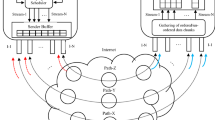Abstract
A sliding window mechanism is well known to be a convenient way to integrate cumulative acknowledgement and flow control functions in a simple manner. Hence, widely used reliable data-transfer protocols such as TCP-SACK and RLC utilize this sliding window mechanism in conjunction with a selective-repeat ARQ (automatic repeat request) function, namely, the selective-repeat sliding window protocol (SR-SWP). We demonstrate that SR-SWP yields a throughput restraint effect (TORE) in particular situations when packet losses occur. We propose an analytical performance model to represent the TORE in the case of heavy traffic. Using this model, we derive explicit forms of goodput and mean resequencing delay, which are fundamental qualities of service parameters. From numerical results, we demonstrate that the impact of TORE on the performance is not negligible for high packet-loss probabilities. Furthermore, we show that the SR-SWP model exhibits the lower goodput and the smaller mean resequencing delay than those obtained from the traditional SR-ARQ protocol model.
Similar content being viewed by others
References
Doeringer, W. A., Dykeman, D., Kaiserwerth, M., Meister, B. W., Rudin, H., & Williamson, R. (1990). A survey of light-weight transport protocols for high-speed networks. IEEE Transactions on Communications, 38(11), 2025–2039.
Elaarag, H. (2003). Improving TCP performance over mobile networks. ACM Computing Surveys, 34(3), 357–374.
Lin, S., Costello, D. J., & Miller, M. J. (1994). Automatic-repeat-request error-control schemes. IEEE Communication Magazine, 22(12), 5–17.
Iren, S., Amer, P., & Conrad, P. T. (1999). The transport layer: tutorial and survey. ACM Computing Surveys, 31(4), 360–405.
Hassan, M., & Jain, R. (2003). High Performance TCP/IP networking: concepts, issues, and solutions. Englewood Cliffs: Prentice-Hall.
Tanenbaum, A. S. (1996). Computer networks (3rd ed.). Englewood Cliffs: Prentice-Hall.
Mathis, M., Mahdavi, J., Floyd, S., & Romanow, A. (1996). TCP selective acknowledgment option. Network Working Group Request for Comments, no. RFC 2018.
Medina, A., Allman, M., & Floyd, S. (2005). Measuring the evolution of transport protocols in the Internet. ACM Computer Communication Review, 35(2), 37–52.
3rd Generation Partnership Project. (2005). Technical specification group radio access network; Radio link control (RLC) protocol specification [online]. Available: http://www.3gpp.org/.
Luo, W., Balachandran, K., Nanda, S., & Chang, K. (2005). Delay analysis of selective-repeat ARQ with applications to link adaptation in wireless packet data systems. IEEE Transactions on Wireless Communications, 4(3), 1017–1029.
Barakat, C., & Fawal, A. (2004). Analysis of link-level hybrid FEC/ARQ-SR for wireless links and long-lived TCP traffic. Performance Evaluation, 57(4), 453–476.
Ikegawa, T. (2002). Comparative performance analysis of basic window size adjustment algorithms for dynamic-window flow control in interconnected network environments. In Proc. of NPDPA 2002 (2002 IASTED international conference on networks, parallel and distributed processing, and applications) (pp. 117–125). October 2002.
Rosberg, Z., & Shacham, N. (1989). Resequencing delay and buffer occupancy under the selective-repeat ARQ. IEEE Transactions on Information Theory, 35, 166–173.
Kim, J. G., & Krunz, M. M. (2000). Delay analysis of selective repeat ARQ for a Markovian source over a wireless channel. IEEE Transactions on Vehicular Technology, 49(5), 1968–1981.
Rossi, M., & Zorzi, M. (2003). Analysis and heuristics for the characterization of selective repeat ARQ delay statistics over wireless channels. IEEE Transactions on Vehicular Technology, 52, 1365–1377.
Rossi, M., Badia, L., & Zorzi, M. (2005). On the delay statistics of SR ARQ over Markov channels with finite round-trip delay. IEEE Transactions on Wireless Communications, 4, 1858–1868.
Rossi, M., Badia, L., & Zorzi, M. (2006). SR ARQ delay statistics on N-state Markov channels with non-instantaneous feedback. IEEE Transactions on Wireless Communications, 5, 1526–1536.
Anjum, F., & Tassulas, L. (2003). Comparative study of various TCP versions over a wireless link with correlated losses. IEEE/ACM Transactions on Networking, 11(3), 370–383.
Sikdar, B., Kalyanaraman, S., & Vastola, K. S. (2003). Analytic models for the latency and steady-state throughput of TCP Tahoe, Reno, and SACK. IEEE/ACM Transactions on Networking, 11(6), 959–971.
Wright, G. R., & Stevens, W. R. (1995). TCP/IP illustrated, vol. 2: the implementation. Reading: Addison-Wesley.
Stevens, W. R. (1994). TCP/IP illustrated, vol. 1: the protocols. Reading: Addison-Wesley.
Padhye, J., Firoiu, V., Towsley, D. F., & Kurose, J. F. (2000). Modeling TCP Reno performance: A simple model and its empirical validation. IEEE/ACM Transactions on Networking, 8(2), 133–145.
Blanton, E., Allman, M., Fall, K., & Wang, L. (2003). A conservative selective acknowledgment (SACK)-based loss recovery algorithm for TCP. Network Working Group Request for Comments, no. RFC 3517.
Yajnik, M., Moon, S., Kurose, J., & Towsley, D. (1999). Measurement and modelling of the temporal dependence in packet loss. In Proc. IEEE INFOCOM ’99 (pp. 345–352).
Zorzi, R., Chockalingam, A., & Rao, R. (2000). Throughput analysis of TCP on channels with memory. IEEE Journal on Selected Areas in Communications, 18(7), 1289–1300.
Kemeny, J. G., & Snell, J. L. (1960). Finite Markov chain. New York: Van Nostrand Reinhold.
Floyd, S. Measurement studies of end-to-end congestion control in the Internet [online]. Available: http://www.icir.org/floyd/ccmeasure.html
Nam, C. H., Liew, S. C., & Fu, C. P. (2002). An experimental study of ARQ protocol in 802.11b wireless LAN. In Proc. of wireless personal multimedia communications (WPMC’02), October 2002.
Mathis, M., & Mahdavi, J. (1996). Forward acknowledgement: refining TCP congestion control. ACM Computer Communication Review, 26(4), 281–291.
Author information
Authors and Affiliations
Corresponding author
Additional information
This work was done mainly while T. Ikegawa was with NTT Network Service Systems Laboratories.
Rights and permissions
About this article
Cite this article
Ikegawa, T., Takahashi, Y. Sliding window protocol with selective-repeat ARQ: performance modeling and analysis. Telecommun Syst 34, 167–180 (2007). https://doi.org/10.1007/s11235-007-9032-6
Published:
Issue Date:
DOI: https://doi.org/10.1007/s11235-007-9032-6




